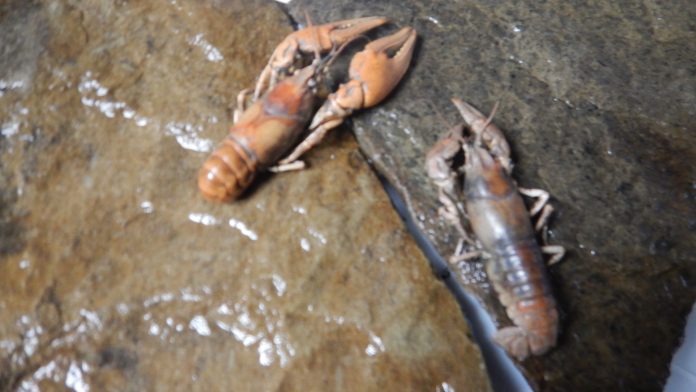Crayfish, also called crawfish or crawdad, nearly all live in fresh water. They are characterized by a joined head and thorax, or midsection, and a segmented body, which is sandy yellow, green, red or dark brown in color.
The head has a sharp snout, and the compound eyes are on movable stalks.
Now that you have a visual, I know what you are thinking, what could I possibly learn from a lobster-looking creature that can pinch?
Set up
For the Jefferson Soil and Water Conservation District staff, it all begins early on a weekday morning. We head to the designated stream armed with stream nets, turbidity tubes, waders and a multitude of other supplies.
We know that we have only a short period of time to set up for the day with classes of students. Silently, we each go about our defined tasks. We know the routine.
Flagging set along the streambank in intervals of 100 feet, locating the best riffle areas, and defining off-limit stream areas is the repetitive process we follow for all of our stream activity programs.
All of this in preparation of introducing students to the concept of healthy aquatic ecosystems and how bugs are affected by the conditions of the stream.
These bugs, macroinvertebrates, are organisms that lack an internal skeleton and are large enough to be seen with the naked eye. Some macroinvertebrates are sensitive to changes in stream conditions brought about by the pollutants.
These organisms may leave to find other habitats, or may not survive the polluted conditions. Some are tolerant to these conditions and can survive.
Students arrive
And now, the students have begun to arrive. Some secretly doubtful to participate in an unfamiliar activity while others are just eager for a day outside of the classroom.
We begin our session with a discussion of the watershed concept and how land uses can produce conditions that impact the stream. Of course, by this time, we have all but lost their attention.
We cannot compete with the large traveling branch heading downstream or the loud squawks from the great blue heron. We need to reign them in.
Okay, down to the stream we go. A quick lesson is in order on how to properly kick seine to collect macroinvertebrates followed by instructions on how to identify the little critters.
Students are divided into teams and are issued their nets, record-taking materials and monitoring supplies.
Reluctance
This is about the time that the reluctance and indecisions kick in. The standard explanations for not wanting to participate are ” I don’t like bugs,” ” I do not want to get wet” and “my boots have a hole.”
Those students have now been assigned the recorder responsibilities staying on the stream bank while the remaining members of their team are wading to their assigned riffle to conduct the bug collections.
Fast forward, we hear screams of enthusiasm from one team. Their net is filled with a diversity of specimens. Most exciting, per the students, is a huge collection of crawdads.
We hear their strategy, “someone needs to grab them from the net and put them in the container before they get away.”
Followed by, “not me, or I don’t want to get pinched, or I didn’t know that they got that big!”
Okay, now we have a standstill. What happens next is what I refer to as an animal-assisted diversion, a courage motivator that relieves the student of tension and anxiety.
Taking inventory
Without hesitation, their team recorder rushes to the aid of the team, oblivious to the water path that stands in the way of the prized inventory of species.
The student proceeds to seize each specimen with precision and deposits them in the provided containers, thereby managing to salvage the first of the three kick seining collections.
Without missing a beat, the recorder is now playing the dual role of the team’s net holder.
What has happened here makes a great case for support of outdoor, hands-on learning.
Best day ever
When the class arrived earlier in the day, the teacher had confided in our staff that the above-mentioned team recorder had previously visited the principal’s office to plead absence from the field trip.
It seems that the student was not acclimated to outdoor activities, did not like to be in the out-of-doors and wanted to be excused.
The principal, while sensitive to the student’s concerns, highly encouraged the pupil to attend to at least experience a limited exposure to nature.
As the teams were completing their species inventory, cleaning out the nets, and dumping water out of their boots, the once fearful student exclaimed, “this is the best day ever!”
Well, now tell me that we can’t learn something from a crayfish.













